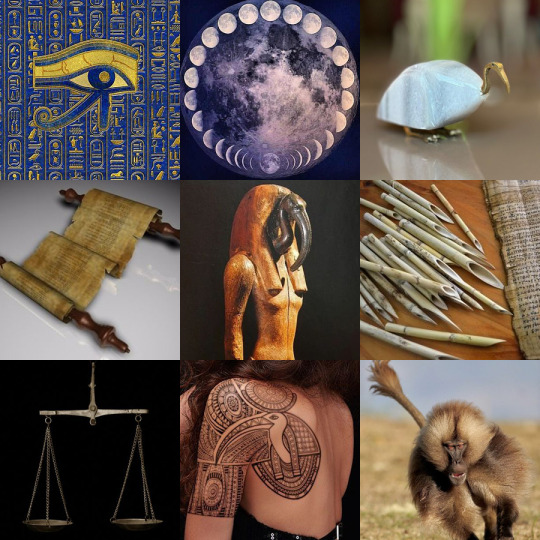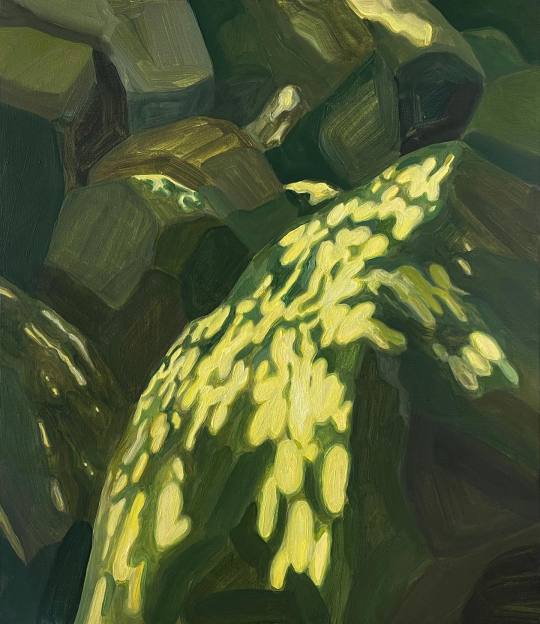Text

30 day moodboard challenge (original list)
Day 27: An Egyptian god
Thoth
16 notes
·
View notes
Text
Noticing there are exactly. Three (3) kinds of songs on Thoth's playlist



Songs that literally have one version or another of his name in the title,
making fun of him with song titles,
or 60's-early 90's alternative, psychadelic/psychedelic-adjacent, and art-genres
#crack posting#thoth#both bast and set's playlists on the otherhand are all over the damn place lmao#thoth also has the secret fourth option that's just 'this is his face/voiceclaim'
0 notes
Text
Triads & Groups of Gods
Traditional
Ogdoad
In the creation myth posited by Hermopolis, this consisted of eight (hence ogdo-) gods and goddesses in wedded pairs. Amun & Amunet, Nu & Nanuet, Heh & Hauhet, and Kek & Kauket. The male deities all were frog-headed, and the female serpent-headed. Depending on the text, these deities were either created by Thoth or hatched from an egg the god laid. Either way, Thoth was a vital figure in this creation myth as he was Hermopolis’ patron god.
In terms of EoK, the Netjeru belonging to this group have been rearranged, but still follow the paired motif. For EoK it's Amun & Mut, Ra & Apep, Ptah & Khnum, and Thoth & Neith. While Nu is still an important factor, they aren't technically part of the Ogdoad in this telling- rather its origin.
Ennead
The Heliopolis creation myth (and arguably best known of the various Ancient Egyptian creation myths) focuses on the Ennead, a family lineage of nine (enne-) deities rather than eight. This started with Atum-Ra, then his children Shu & Tefnut, on to their children Geb & Nut, then finally their children Osiris, Set, Isis, & Nephthys.
In terms of EoK, neither Atum nor Ra are included in the Ennead- the former having split into Amun and Ra, the latter belonging to the Ogdoad instead. As such, the Ennead line instead begins with Shu and Tefnut, then Geb & Nut, then Osiris, Horus-Ur (Horus the Elder), Set, Isis, and Nephthys. Horus-Ur is ultimately slain by a scorpion sting compounded by his younger brother Set's negligence, his place in the Ennead being filled once more by his reincarnation Horus the Younger. Though Anubis is an important piece of the royal family, he is not included in the Ennead.
Memphis Triad
The most variable of traditional triads. Ptah was always involved as he was the patron of Memphis, but his wife could be either Sekhmet or Bast and their son could either be Maahes or (more commonly) Nefertem.
For EoK, this triad consists of Ptah, Sekhmet, and either Maahes or Nefertem interchangeably.
Elephantine Triad
Traditionally, this was usually Khnum, Satet, and their daughter Anuket. This is the configuration chosen for EoK.
Theban Triad
This was almost always Amun, Mut, and their son Khonsu. As the only variable deities are not featured in this project, this is the configuration chosen for EoK.
Four Sons of Horus
While the members of this group never differed, their parents often did. Traditionally, the brothers were each fathered by Horus-Ur, their mother being Isis and were guarded by other goddesses; Isis for Imsety (the human-headed son), Nephthys for Ahephi (baboon-headed), Neith for Duamutef (jackal-headed), and Serqet for Qebesehnuef (falcon-headed.) Alternatively, they were sometimes said to be children of Amun, Nut, or Geb- and in the Middle Kingdom, Renenutet was associated with Qebesehnuef and Sendjet (not featured in EoK) with Duamutef.
For EoK, the brothers’ father is both Horus-Ur and Horus the Younger- the tl;dr explanation being the god is technically both at the same time, but Horus the Younger is the one occupying physical space. Their mother is Hathor, who had a relationship with Horus-Ur long before marrying Horus the Younger.
Court of Osiris
Like many things in the Kemetic mythos, the deities of Osiris’ Hall of Two Truths could vary. Most commonly depicted (besides the King of the Underworld himself) were Anubis, Thoth, Ma'at, and Ammit. Additional deities that appeared were Nephthys, Isis, Horus (typically the Elder, sometimes the Younger), Babi, Meskhenet, Shai, and the Four Sons of Horus.
In terms of EoK, and for the sake of giving some deities more concrete roles/existences, many have been made official members of Osiris’ court. In addition to those most commonly featured in tradition, there is; Shezmu, Seshat, Renenutet, Sepa, Medjed, Wepwawet, and Astennu (linked with Babi.)
Crew of Ra's Barque
Another assortment that varied wildly in the traditional text. In all honesty, besides Ra himself Set was the most consistent deity present on the Mandjet or Boat of Millions (considered one and the same for EoK.) Mentioned as company for Ra as well were Horus (typically the Horus-Ur), Khepri, Shu, Tefnut, Geb, Nut, Isis, Nephthys, Osiris, Khnum, Nehebkau, Thoth, Anty (another name for Nemty in EoK), Heka, Sia (not featured in EoK), Hu (not featured), Mehen (not featured, attributed as a facet of Nehebkau), and undoubtedly more that I'm missing.
For EoK, this has also varied over the course of history, some deities leaving while others joined. Presently, Ra's crew consists of Khepri, Aqen, and Heka. Set occasionally accompanies Ra after being banished, but exclusively through the Duat. Previous crew members are Horus-Ur, Hathor-Sekhmet, Tefnut, Shu, Thoth, and Nehebkau.
EoK Groups
Divination Triad
This is the wedded trio of Meskhenet, Renenutet, and Shai (or Shait when depicted as a woman.) This group isn't exactly named in any texts as far as I know, but they’re most often depicted in relation to one another- albeit typically either Meskhenet OR Renenutet alongside Shai. Each have a connection to telling the future of a soul (new or reborn, mortal or divine), and each have sway over a soul's fate in the afterlife.
Eyes of Ra
While many deities (almost exclusively goddesses) held this title throughout the traditional mythos, this was almost always in objection to one another. It was Bast OR Hathor OR Sekhmet OR Wadjet OR, so on and so forth. For EoK, there have been only 3 Eyes, the title taken from one daughter of Ra by their father then given to another. In order, they are Tefnut, Hathor-Sekhmet, and finally Bast.
0 notes
Text
ALSO. I GOT ALL THE OVERVIEWS DONE. Just gotta check the Osiris and Contendings myths to make sure I didn't miss anything, then I can get to Actually writing

1 note
·
View note
Note
Oh knower of extremely niche topics (mean that in a positive way), is there any historic mention of vampirism in ancient egypt??
Not to my knowledge, no. I know that a handful of vampire media claims that there were vampires in Ancient Egypt- some even being nobility or rulers- but there are no historical texts which support this being a belief that was held as far as I know. I've also seen it proposed by a small few that Osiris was a vampire, which I have to respectfully reject outright.
HOWEVER, vampires and vampirism are European concepts, but have similarities with pieces of a variety of other cultures. Generally speaking, the oldest mentions of creatures that broadly match the traditional description of a vampire come from the ancient Near East. While Egypt isn't one of these sources, it neighbored them and its culture mingled with theirs'. As I said, there is nothing in Egyptian mythology or ancient history which lines up with tales of vampires enough to equate them, but there are a handful of deities and concepts which have similarities.
Sekhmet comes to mind first and foremost, with her power over disease and infamous gluttonous bloodthirst. I have seen a handful of other people posit Sekhmet as the "original" vampire, but I disagree for a few major reasons. First of all, she has no connection with death nor the afterlife beyond being a slayer and protectress; she is tied to life and strength of the living Pharaoh, rather than the afterlife. Secondly, while she does cause and spread disease, she is also responsible for healing these and this is just as vital to her divine "role" so to speak; traditionally speaking, vampires strictly spread pestilence and have no connection (nor reason to have one) with curing or healing. Third, she is unique and possesses no contagious quality like some tales of vampires; her thirst for blood was entirely her own, not transmitted by some other source nor imparted to any others.
Other deities noted for drinking or feasting on blood include Shezmu, who (in some tellings) put Ra/Osiris' enemies into his press to make wine from their blood, and also played a major role in the Cannibal Hymn (thought this was mostly symbolic rather than actual cannibalism); Ammit, who not only feasted on the hearts of the unworthy but delighted in chowing down on the rest of their bodies; Babi, who much like Ammit would devour those deemed sinful and would occasionally fill her role, though entrails were noted as his preferred snack; and Khonsu, who is also noted in the Cannibal Hymn and has the epithet "lives on hearts." I'm certain there are others worth mentioning that I've managed to overlook, but these are who came to my mind.
Lastly, though they are not considered gods by any means and have a very loose definition, the wandering-demons as a whole are worth mentioning here. Some are said to eat or otherwise prey on humans, even attempt to steal their souls whilst sleeping- but I bring them up more for their direct ties to things like pestilence, famine, and drought. Both Sekhmet and Bast supposedly commanded legions of these wandering-demons, though I personally think this is another case of Bast being conflated with her sister; Bast has no real connection to disease or healing them specifically, and the sickness which Sekhmet unleashed was spread by her wandering-demons. (I specify wandering-demons as they're distinct from guardian-demons like Ammit or Babi, but that's a whole different, extremely complicated and long winded matter lol)
0 notes
Text
I'M LATE. But Khonsu a real one, drive-by flipping off Ra on Thoth’s behalf <3
#kirby's yelling#or. more accurately. kirby's shitposting that requires context of plot points not yet public to understand jfjdkdks
2 notes
·
View notes
Text
HRNRHRGRHRN I HAVE. ALL THE PLOT OUTLINES BUT ONE OF THE MAIN MYTHS FINISHED.

The Contendings is going to be a Bitch I already know, the Osiris myth is going to run long but I fear the Contendings will only be worse qvq But I have I think four(?) more days of this sort of vacation that consists mostly of sitting around and brought I my puter for just this reason. Yippeeeeee
0 notes
Photo



Made in the shade, Duri Baek
7K notes
·
View notes
Text
Steps up on my soapbox. Clears my throat.
Djehuty "Refuses To Have A Real Sleep Schedule" Thoth falling asleep at his desk in the Hall of Two Truths. And then abruptly waking to find an entire Medjed standing on his desk. And the scroll he was working on. Staring down at him. Without blinking. For a very long time. Feet all over his fucking fresh ink.
Thank you for your attention.
#crack posting#thinking about That Smiter™️ after talking about it with a friend#amogus god I love youuuuu
0 notes
Text

Statue of Princess Takushit, c.670 BC
5K notes
·
View notes
Text
“How’s your WIP going?”

"Have you made any progress?”

“How close are you to being done?”

44K notes
·
View notes
Text
guy tries to toss a cigarette on the ground but the ground parries it and it flies back into his mouth and he solemnly continues to smoke it
73K notes
·
View notes
Text

I am. SO very close to finishing the introductory slides, but realized I had to fix two wee errors in this clusterfuck reference. Just like the last times, there's a written explanation under the cut qvq
Origin
Nu
[ Atum is fashioned by his parent Nu, but later separates into Amun and Ra ]
First Generation
Amun, first child of Nu and half of Atum
Mut, second child of Nu and Amun's wife
Ra & Apep, twins, third and fourth children of Nu (and, for Ra, half of Amun)
Ptah, fifth child of Nu
Khnum, sixth child of Nu
Thoth, seventh child of Nu
Neith, eigth child of Nu
[ Ma'at and Nehebkau are created by Ra's fire and Apep's blood respectively before the start of the second generation ]
Second Generation
Khonsu, son of Amun and Mut
Tefnut & Shu, twins, second and third child of Ra
Shezmu, born of Apep's blood
Ahti, born of Apep's spit
Babi-Astennu, born of Apep's seed
Hathor-Sekhmet, fourth child of Ra
Heqet, created by Khnum
Hapi & Satet, twins, fifth and sixth children of Ra, Satet is Khnum's wife
Bast, seventh child of Ra
Montu, eigth child of Ra
Third Generation
Anhur, ninth child of Ra
Ammit, born of Apep's bile
Geb, first child of Tefnut and Shu
Nut, second child of Tefnut and Shu, and wife of Geb
Mafdet, adopted by Ra (10th child)
Reshep, foreign god married to Qetesh
Anat & Astarte, twins, foreign goddesses adopted by Ra (11th and 12th children), both married to Set
Mehit, foreign goddess married to Anhur
Qetesh, goddess adopted by Ra (13th child), wife of Reshep
Nefertem, first child of Sekhmet and Ptah's relations
Maahes, second child of Sekhmet and Ptah's relations
Serket, first child of Neith and Khnum
Sobek, second child of Neith and Khnum
Fourth Generation
Min, child of Reshep and Qetesh
Anuket, child of Satet and Khnum
Osiris, first child of Geb and Nut
Horus-Ur, second child of Geb and Nut
Set, third child of Geb and Nut
Isis, fourth child of Geb and Nut
Nephthys, fifth child of Geb and Nut
[ Before the start of the fifth generation; Heka is created by Ma'at and Thoth, Khepri is created by Ra (14th child) and incubated by Thoth, and Hatmehit is created by Abtu the Fish swallowing then spitting out Osiris' penis (which was severed by Set) ]
Fifth Generation
Anubis, child of Osiris and Nephthys' affair
Horus (the Younger), child of Osiris and Isis, and reincarnation of Horus-Ur
Wepwawet, child of Neith and Set's affair
Tutu, child of Neith and a pre-Egyptian settlement hunter
Sixth Generation
Nekhbet & Wadjet, twins, 15th and 16th children of Ra
Kebechet, pupil and unofficially adopted daughter of Anubis
Ahephi, Imsety, Daumutef, & Qebehsenuef, quadruplets, the four sons of Horus and Hathor (via fling with the Elder, marriage with the Younger)
6 notes
·
View notes
Text
Love finding out. After I've already used the alternative name for him upwards of 10 times in important posts/docs. That the name I chose to use for the baboon son of Horus to not confuse him with another deity of the exact same name is in fact Something Somebody Made Up. This is 1000% fine

2 notes
·
View notes
Text
Crowns of Ancient Egypt
A brief overview of the different kinds of crowns seen in Ancient Egyptian iconography. Note that I say crown, note headdress; the well-known nemes headdress and similar things not worn by the king and gods will not be covered.
Hedjet: translates as “White One,” the crown of Upper Egypt. Most famously worn by Nekhbet, Horus, and Satet. Nekhbet, the Patroness of Upper Egypt, was occasionally placed on the brow of this crown as an ornamental vulture.
Deshret: translates as “Red One,” the crown of Lower Egypt. Most famously worn by Wadjet, Horus, and Neith. Like her sister, Wadjet- the Patroness of Lower Egypt- would commonly adorn the crown as a uraeus. However, this symbol was featured on a majority of the other crowns as well.
Atef: a hedjet crown with two ostrich feathers on opposite sides. Most commonly associated with Osiris and his followers, but was also worn by Underworld related deities like Sokar.
Hemhem: translates as “to shout,” “cry out.” This translation has led to speculation that it was associated with battle or military power. It’s three atef crowns placed side by side atop curled ram horns; sometimes there is a solar disc above each atef, sometimes just the middle one, sometimes not present. Not specifically associated with any one deity, but Khnum and Sobek are often depicted wearing one.
Pschent: also called sekhemty- translating as “the Two Powerful Ones”- it combines the hedjet and deshret to become the crown of a unified Egypt. Though the Pharaoh Menes is said to have first united the crowns, surviving records show Djet was the first to wear it. Horus is the deity most commonly associated with it, but Atum-Ra was also shown wearing the double crown at times. The Two Ladies Nekhbet and Wadjet would both adorn this crown side by side, further symbolizing the union of Upper and Lower Egypt.
Khepresh: known to exist in the second intermediate period, but popularized in the New Kingdom; worn by pharaohs for militaristic and possibly religious purposes. It isn’t associated with any deities, but as with most royal headdresses it often featured a uraeus.
Cap Crown: one of the oldest crowns of Egypt recovered by Egyptologists, depictions of it stretch as far back as the Old Kingdom. Again, no particular deity is associated with it, seemingly exclusive to the human Pharaoh, but it did almost always feature a uraeus.
Solar Crown: also called a solar disc, this was used to not only signify a solar deity but royalty. It’s most commonly associated with Ra, but many other deities have worn one, even if only in rare depictions. Most commonly, the solar crown is also worn by deities like Horus-Ur (Horus the Elder), Isis, Hathor-Sekhmet, Amun, Tefnut, Bast.
Lunar Crown: like the solar crown, this can also be alternatively described as a lunar disc. Unlike its counterpart, however, it was rarely described with a single phrase despite being not uncommon in depictions. The closest it had to its own word was shared with the moon in general. The crown itself was depicted with the full moon resting in the curve of an upturned crescent moon. Deities like Khonsu and Thoth are most associated with this crown, but Tefnut and Mehit also wore it occasionally.
Two-Feathers Crown: also called the Amun crown as it was most commonly associated with him, but it is also worn by Montu and Min. Unlike the atef, these feathers are described as those of a falcon rather than an ostrich- but similar to the hemhem, they’re placed atop two ram horns and sometimes feature a solar disc.
4 notes
·
View notes
Text
The best notes written in manuscripts by medieval monks
Colophon: a statement at the end of a book containing the scribe or owner’s name, date of completion, or bitching about how hard it is to write a book in the dark ages
Oh, my hand
The parchment is very hairy
Thank God it will soon be dark
St. Patrick of Armagh, deliver me from writing
Now I’ve written the whole thing; for Christ’s sake give me a drink
Oh d fuckin abbot
Massive hangover
Whoever translated these Gospels did a very poor job
Cursed be the pesty cat that urinated over this book during the night
If someone else would like such a handsome book, come and look me up in Paris, across from the Notre Dame cathedral
I shall remember, O Christ, that I am writing of Thee, because I am wrecked today
Do not reproach me concerning the letters, the ink is bad and the parchment scanty and the day is dark
11 golden letters, 8 shilling each; 700 letters with double shafts, 7 shilling for each hundred; and 35 quires of text, each 16 leaves, at 3 shilling each. For such an amount I won’t write again
Here ends the second part of the title work of Brother Thomas Aquinas of the Dominican Order; very long, very verbose; and very tedious for the scribe; thank God, thank God, and again thank God
If anyone take away this book, let him die the death, let him be fried in a pan; let the falling sickness and fever seize him; let him be broken on the wheel, and hanged. Amen
181K notes
·
View notes
